-Leandro-Tumenas-2.jpg)
Beatriz Milhazes. Photo © Leandro Tumenas.
by DAVID TRIGG
The exuberant paintings and collages of Beatriz Milhazes (b1960, Rio de Janeiro) teem with swirling organic forms, floral motifs and hard-edged geometries. Characterised by their carnivalesque colours and vibrant, decorative surfaces, they evoke the tropical climate and culture of her native Brazil. “My big ambition is always to try to do something new with abstraction,” says Milhazes, whose major survey at Margate’s Turner Contemporary, her first institutional show in the UK for more than 20 years, brings together 25 paintings and works on paper from a lively 40-year career. “I feel like a scientist; it’s about experimenting and challenging myself,” she enthuses as she talks about the evolution of her practice, which since the 1980s has embraced a range of approaches, interweaving influences from art history and her Brazilian heritage with references to vernacular culture and the natural world.
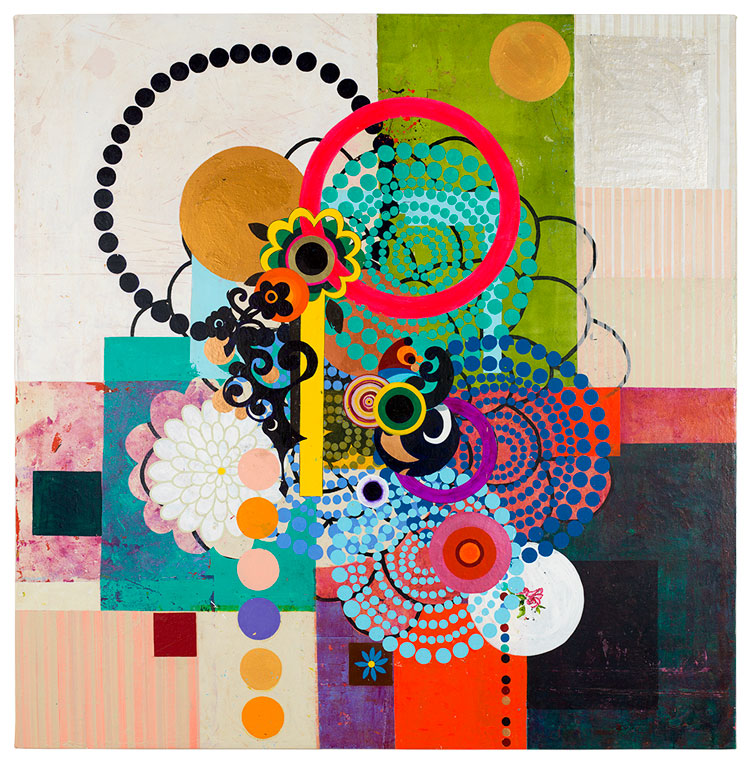
Beatriz Milhazes. O Turista, 2004–05. Acrylic on canvas, 199 x 195 cm. Cranford Collection, London. Photo: Manuel Águas and Pepe Schettino. © Beatriz Milhazes Studio.
Growing up under the Brazilian military dictatorship of 1964-85, Milhazes came to prominence in the 80s as part of a new generation of artists who embraced painting over the prevailing conceptual practices of the previous decade. Many were included in the landmark 1984 exhibition Como Vai Você, Geração 80? (How Are You, 80s Generation?), which signalled a return to colour and painterly expression. “We wanted the freedom to be able to express ourselves and develop our own language,” she says. This did not mean they were apolitical or lacking in social consciousness. “We were criticised by people who said our work was the expression of an ‘empty mind’, but, in fact, it was just the opposite. I’ve been political my entire life, but not always in an obvious way.” Geração Oitenta (Eighties Generation), the catchall term often applied to Milhazes and her peers, was less a movement than “a moment”, one that reflected the optimism of the era as military rule began to crumble and Brazilian democracy emerged. “The exhibition attracted thousands of people,” she says. “It was at the very end of the dictatorship, and this was part of the process of getting rid of it.”
After studying journalism at Hélio Alonso University in Rio, Milhazes decided instead to pursue art. She enrolled at the city’s progressive Parque Lage School of Visual Arts, which by the early 80s was considered a centre of resistance against the regime. “The art school had become something really important by then,” says Milhazes, who describes her decision to switch careers as “like receiving a mission”. She studied under Charles Watson, an influential Scottish-born educator who had relocated to Rio in 1978. “He brought us a lot of knowledge about the concepts of European art, American art and constructive art in Brazil,” she says. “This was important because we didn’t know what was happening in America or Europe at that time. Cultural information was limited, and communication was very closed off. There were no computers, smartphones or internet, everything was very basic. Charles introduced an international method of teaching, having observed European and American artists.”
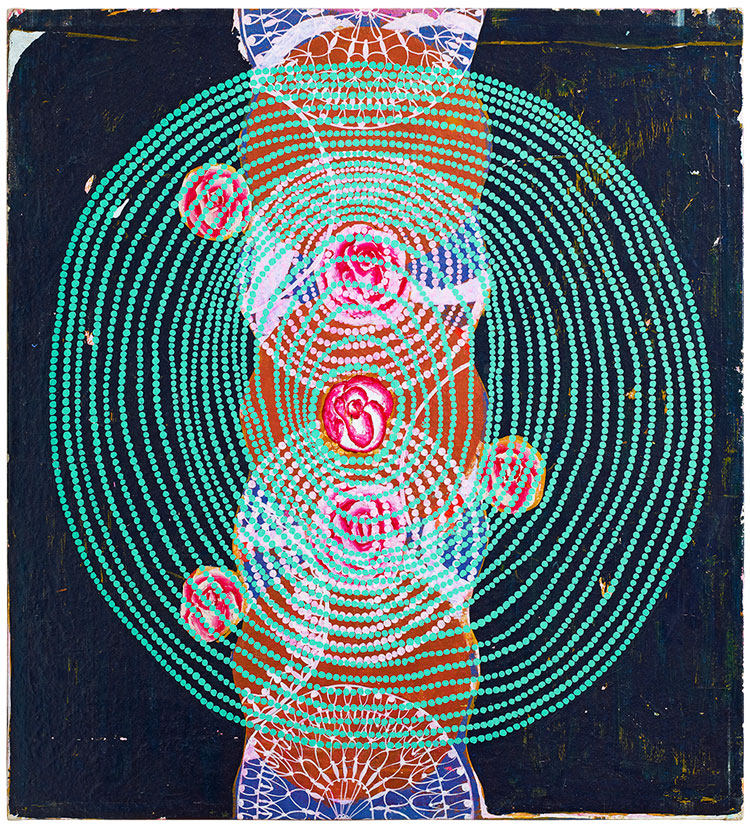
Beatriz Milhazes, A Flor da banana, 1993–94. Acrylic on canvas, 97 x 88 cm. Courtesy of Ivor Braka. Photo: Stephen White. © Beatriz Milhazes Studio.
Milhazes had already learned about European modernists such as Piet Mondrian, Sonia Delaunay and Henri Matisse from her mother, an art historian, and the books that she had access to at home. Matisse’s paintings and cut-outs have since become a touchstone of her practice. However, in the 40C tropical heat of Rio, she found it “hard to think like Matisse”. This prompted her to begin experimenting with fusing elements of European modernism with Brazilian culture, combining high-art sensibilities with elements of Rio’s vernacular architecture and carnival culture. This was encouraged by Watson. “At that time, these kinds of things from the applied arts, women’s labour and so-called ‘popular art’ were considered to be for uncultured people, but Charles understood my ideas and thought that introducing them to my work could be interesting,” she says.
The results of these ideas are seen in highly patterned pieces such as Eu Só Queria Entender Por Que Ele Fez Isso (I Just Wanted to Know Why He Did This) (1989), the earliest of Milhazes’ works at Turner Contemporary, which is comprised of lace and hand-painted floral motifs arranged in vertical bands. Nearby, Casa da Maria (1992) references the history of dressmaking and women’s domestic labour in Brazil with elements relating to “the kind of crochet that I remember my grandmother doing”. Milhazes attributes her interest in engaging with her heritage to the deep conversations about Brazilian culture and history and the social context that she had with her family while growing up. “Culturally, my sister and I were very informed through my parents, who are both very intellectual people,” she says, noting that her mother taught art history at Rio de Janeiro state university and her father was a lawyer. “My generation was not so proud about being Brazilian, but my parents always wanted us to understand that there was more to Brazil than this moment of the dictatorship.”
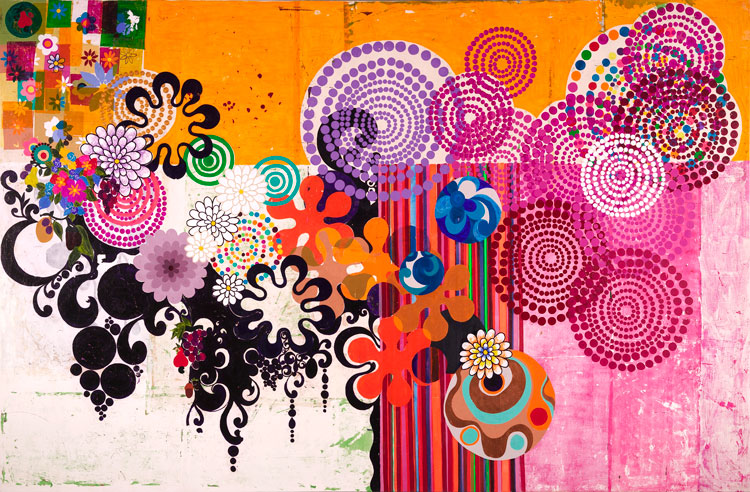
Beatriz Milhazes, O Diamante, 2002. Acrylic on canvas, 250 x 381cm. 'la Caixa' Foundation Contemporary Art Collection. Photo: Vicente de Mello. © Beatriz Milhazes Studio.
Another important influence has been the Brazilian artist Tarsila do Amaral (1886-1973), who developed a distinct Brazilian voice within 20th-century modern art and whose work Milhazes immediately felt “completely connected to”, not least because of her association with “anthropofagia”. Inspired by the poet Oswald de Andrade’s 1928 manifesto Manifesto Antropófago (Cannibalist Manifesto), this radical Brazilian art movement argued that Brazil’s history of assimilating, ingesting and reimagining different cultural traditions, especially those introduced to the country by European colonisers, should form the basis of a truly national aesthetic. “It is based on the idea of culture eating culture,” explains Milhazes, whose early works reflect these ideas where motifs borrowed from Catholic iconography and carnival rub shoulders with the forms of baroque colonial architecture, Brazilian modernist architecture and fabrics sourced from local markets.
Collage was central to Milhazes’ early work and has informed her image-making ever since. “When I started to develop my language, I wanted to work with my culture, my context. I didn’t want to make expressionistic paintings with brushstrokes on the surface. I always liked geometry and constructivism, but I didn’t want just to paint squares or rectangles. So, collage was the way to combine these two worlds,” she says. While the incorporation of printed fabrics, lace, ribbons and paper elements into her canvases was liberating at first, Milhazes began to feel limited by collage. “It had started to become formulaic,” she says. “In the late 80s, I was in a crisis and became very frustrated with my work. I really wanted to use paint, but, at the same time, the idea of collage was still appealing because you have the freedom to juxtapose different elements.”
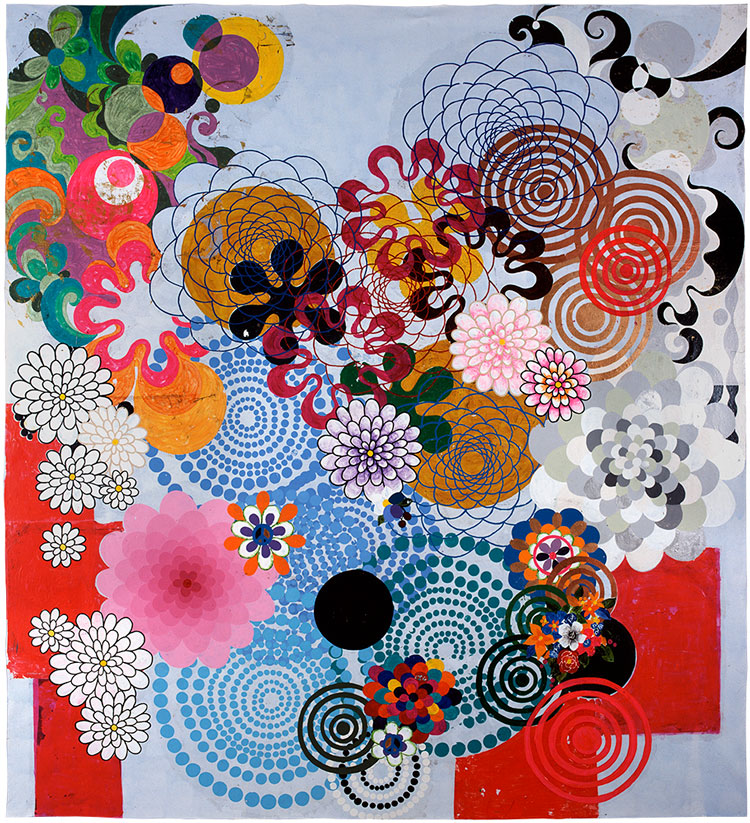
Beatriz Milhazes. Maresias, 2002. Acrylic on canvas, 300 x 267 cm. TBA21 Thyssen-Bornemisza Art Contemporary Collection. Photo: Fausto Fleury. © Beatriz Milhazes Studio.
Her breakthrough came when she decided that, rather than painting her motifs and patterns directly on to canvas, she would paint them on to plastic sheets and carefully transfer them to the painting’s surface. The process, which she calls “monotransfer”, essentially brought the concept of collage into the painterly realm. “I based it on monotype printing,” she says. “I figured out that when the acrylic paint was dry on the sheet, I could stick it to the canvas and peel off the plastic.” Milhazes builds up her motifs in layers until they are thick enough to be glued to the canvas. Only when the glue is dry can the plastic sheet be peeled away, which in the humidity of Rio can take up to 10 hours.
The monotransfer process achieves a smooth surface with little trace of the artist’s hand yet retains a painterly quality since the process is far from precise. Many of the paintings on display in Margate contain areas of broken, seemingly degraded paint – chance marks and residues created by the peeling away of the plastic. These “mistakes” have become integral to the artist’s singular aesthetic. “One of the things I like about the technique is the control it gives me,” she says. “My work is very rational. Even though there are things that happen by chance, whether I keep or exclude them is a rational decision.”
In 2003, Milhazes was selected to represent Brazil at the 50th Venice Biennale. This was a period in which the scale of her work increased significantly. A room at Turner Contemporary is dedicated to these huge, immersive canvases, which anticipate the artist’s move into public art. Their complex surfaces explode with contrasting colours and organic forms, embodying what she describes as “chromatic free geometry,” where structure and order is carefully balanced with a sense of spontaneity and movement. Dominating these compositions are layered patterns of concentric circles, targets, mandala-like configurations and stylised floral elements set against backgrounds of coloured squares, rectangles and stripes – motifs and forms that Milhazes has explored throughout her career. “The circle is an organic shape, it has no end,” she says. “It is spiritual and connected to nature.” Flowers have also been a recurring motif, appearing in her work from the earliest compositions. For her, “they are a part of life, and also death”, ornamenting the beautiful as well as the sad moments.
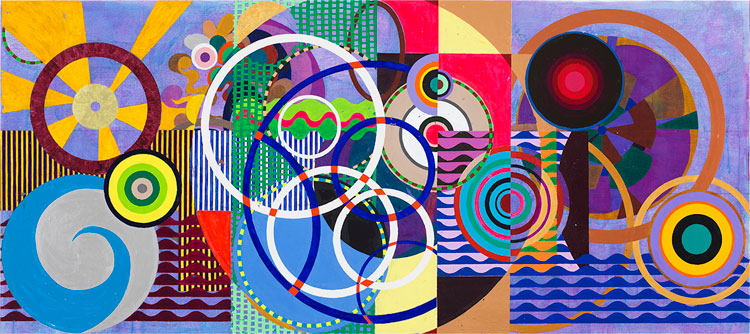
Beatriz Milhazes. Maracorola, 2015. Acrylic on canvas, 128 x 289 cm. Private collection, courtesy of Ivor Braka Ltd. Photo: Manuel Águas and Pepe Schettino. © Beatriz Milhazes Studio.
During the 2000s, Milhazes worked almost exclusively with monotransfer. “I was barely touching the canvas at all,” she recalls, and although the results were visually impressive, she increasingly felt dissatisfied with this way of working. “The paintings were becoming too cold, too clean. I started to miss direct mark-making and wanted to get my hand back into the surface of the works.” Milhazes still uses monotransfer, but now combines it with working on the canvas directly, incorporating into her recent works a greater range of textures and marks. In paintings such as Maracorola (2015), we see repetitive dots, stripes, waves, fragmented geometries and hand-painted motifs. These have been applied using a range of different paints and marker pens, resulting in an image saturated with vibrant colour.
“I don’t fear colour,” says Milhazes. “Many artists do because it is dangerous; you can destroy a work with the wrong combination.” To balance her colours, she does not deploy colour theory or any special formulas but rather relies on intuition. “I really like to work with my intuition but, as I said before, my work is very rational. I’m a colour observer, a colour researcher and my selection is often based on contrast.”
This is also true of the colourful paper collages that she started making in 2003 using found materials such as sweet and chocolate wrappers, shopping bags and silkscreened papers. As with her earliest works, they reflect an interest in colliding high and low culture and feature similar motifs and geometric designs. In some, such as Carlyle (2011), she incorporates hologrammed and glittered papers to create sparkling and iridescent optical effects impossible to achieve with paint. “People have no idea how many papers you need to do pieces like that!” she says. Like her paintings, these highly patterned works have an all-over intensity and the eye finds no place to rest.
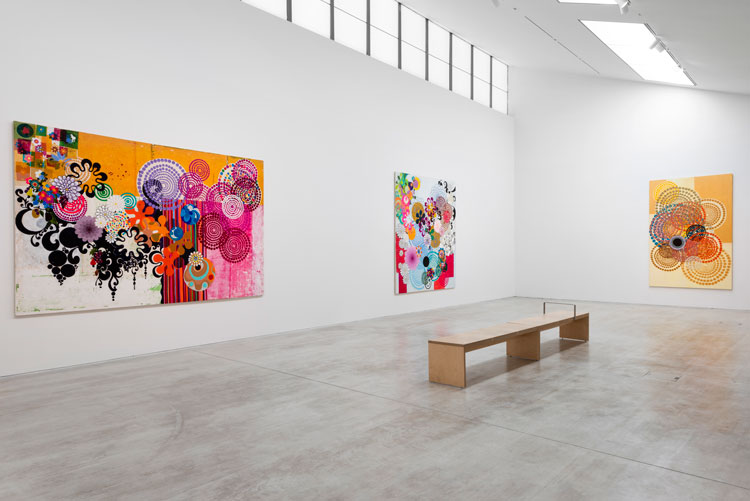
Beatriz Milhazes: Maresias, installation view, Turner Contemporary, 2023. © Courtesy Turner Contemporary. Photo: Thierry Bal.
Natural forms have always been important to Milhazes, but in recent years the natural world has become an increasingly important theme in her work. She is surrounded by nature in Rio and her studio, in the Jardim Botânico district, overlooks the city’s botanical gardens. “I love being surrounded by the gardens, and also the Atlantic Forest. I can see palm trees from my window, which makes me happy to go back to the studio,” she says. “I grew up in Copacabana, so nature was always a part of my life, but my interest became stronger after I started my international career and learned to better appreciate my surroundings at home.” Her Turner Contemporary show emphasises the theme of nature and this is echoed by its title, Maresias, a Portuguese word that refers to the salty sea air common to coastal cities such as Rio and Margate.
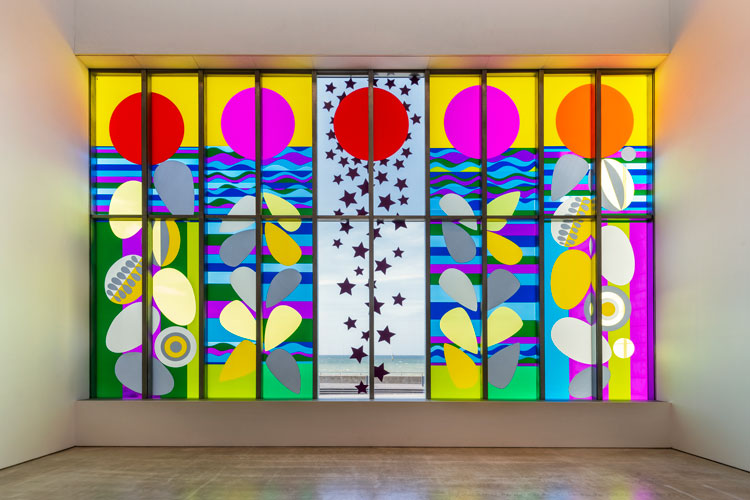
Beatriz Milhazes: Maresias, installation view, Turner Contemporary, 2023. © Courtesy Turner Contemporary. Photo: Thierry Bal.
Turner Contemporary’s seafront location has inspired Milhazes’ installation for the gallery’s Sunley Gallery Window, O Esplendor (2023), which celebrates nature’s ability to uplift and restore. It is the latest of the artist’s site-specific works for buildings and public spaces, which began in 2004 with the facade of the Selfridges department store in Manchester. “Public art is a way to go direct to the people,” she enthuses. The design, which evokes Matisse’s windows for the Chapelle du Rosaire de Vence in France, features various elements seen in Milhazes’ recent paintings, including waves, leaves, stars and circles. “It’s all hand drawn,” says Milhazes, who doesn’t use computers to aid her designs. Each element is individually cut from coloured vinyl, which creates a luminous, stained-glass effect across the window’s 20 panels. “The vinyl is important because it is more vibrant, more real and more effective than printing the image,” she says. The stunning sea view is not totally obscured by the design; the window’s central section, partially filled with stars, allows viewers to gaze out at the vast expanse of the ocean from the spot that famously inspired JMW Turner, who regularly stayed in Margate during the 1830s.
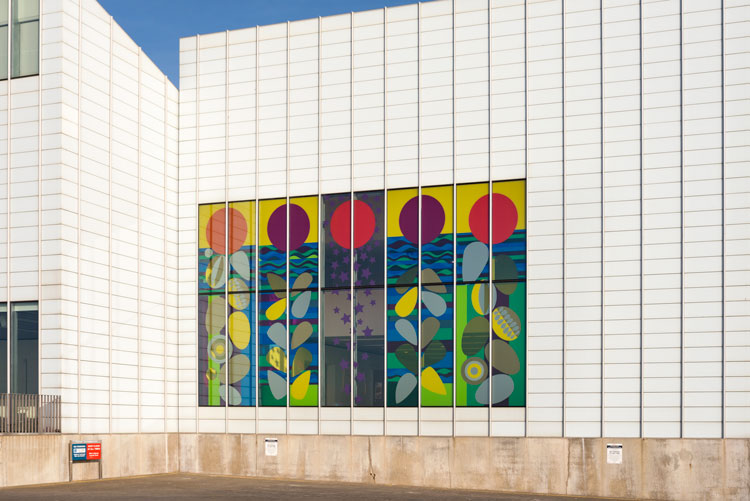
Beatriz Milhazes: Maresias, installation view, Turner Contemporary, 2023. © Courtesy Turner Contemporary. Photo: Thierry Bal.
Living in Brazil, Milhazes is acutely aware of the devastating impact of deforestation and the destruction of nature. “The Amazon problem is getting worse and worse, but the strongest way of fighting exploitation like this is to show people how much we need nature: the leaves, the water, sky and sun,” she says. The plant motifs, rippling waves and radiant suns that appear in her recent works are a celebration of the natural world. They do not speak to environmental breakdown, rather they proclaim the spiritual power of nature and its ability to renew. In this, her works offer an optimistic vision for the future of the environment as opposed to an apocalyptic one. They allude to the fragility of nature and its fecundity, emphasising the important role that it plays in wellbeing. As Milhazes puts it: “For me, nature is life, and my work has always been in favour of life.”
• Beatriz Milhazes: Maresias is at Turner Contemporary, Margate, 27 May – 10 September 2023.